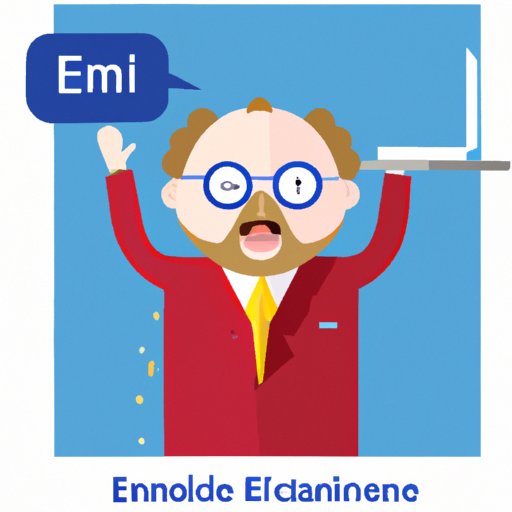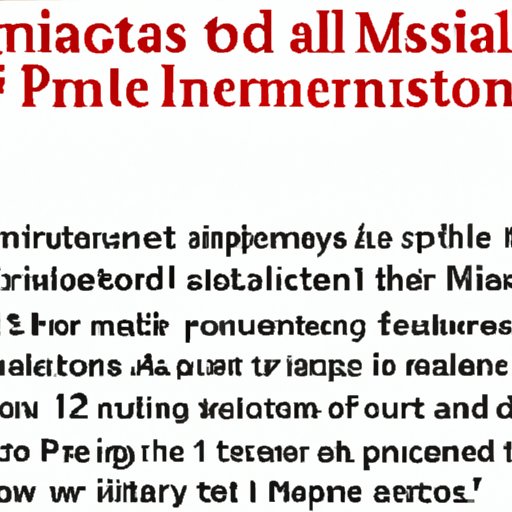
I. Introduction
Communicating with professors is an essential part of academic life, and it is crucial to understand the proper etiquette for email communication. One of the most critical aspects of this etiquette is knowing how to end an email correctly. A well-crafted email ending can help you create a professional image, express gratitude, and show respect to your professor. In this article, we will explore ten polite and effective ways to end emails to professors, provide advice on perfecting email etiquette, and discuss appropriate email closings for different types of emails. We will also give tips on how to create a professional impression and end emails effectively.

II. 10 Polite and Effective Ways to End Your Emails to Professors
Here are ten different ways to end an email to a professor:
- Best regards,
- Thank you,
- Sincerely,
- Respectfully,
- Warm regards,
- Yours truly,
- Kind regards,
- Take care,
- Until next time,
- Looking forward to hearing from you,
Each of these closings can be used in different contexts, such as formal or informal emails, emails asking for help, or sending assignments. Best regards and sincerely are two widely used email closings. Thank you is an excellent choice to show gratitude when a professor takes their time to respond to your email. Respectfully and yours truly are good options for more formal and respectful emails.
III. Perfecting Your Email Etiquette: Advice on Ending Emails to Professors
When emailing a professor, it is essential to pay attention to the tone, language, and formatting of your email. One of the critical aspects of email etiquette is knowing how to close an email politely and professionally. Keep your closing brief to make a great impression on your professor. The most common and professional email closing is sincerely, followed by regards or best regards. However, if you have established a friendly relationship with your professor, you might use closing options such as best wishes or all the best.
IV. Navigating Communication with Professors: Appropriate Email Closings
Depending on the type of email you are sending, there are several appropriate email closings that you can use. For example, when asking for help, you could use the closing, “Thank you for your time and consideration.” If you are submitting an assignment, use the closing, “Thank you for your assistance and feedback.” When thanking your professor for their assistance or guidance, you could use the closing, “Thank you for your help and support.”
V. Creating a Professional Impression: 6 Ways to Close Emails to Professors
Here are six different ways to create a professional impression when ending emails to professors:
- Pick the appropriate closing based on the context of your email.
- Keep your closing professional, unless the email exchange is informal.
- Avoid using emoticons or slang in your email state because this may not convey the professional impression you want to create.
- Your email ending should always match the tone of the email.
- Proofread your email for mistakes and grammatical errors before sending it.
- Add your name and contact information as part of your closing when appropriate, to ensure that your professor can easily contact you if necessary.
Your email closing is an important part of showcasing your professionalism and demonstrates that you have a basic understanding of email etiquette.
VI. End Strong! Tips for Closing Emails to Professors
Here are some tips to help you close emails to professors effectively:
- Be sure to reiterate your gratitude for their guidance or help.
- Include your name and contact information in your signature to make it easy for the professor to respond to your email.
- When responding to a professor’s email, make sure to read the message carefully to avoid asking unnecessary questions.
- End your email with a sentence that is clear and to the point.
Remember, brevity and clarity are essential when ending an email to a professor.
VII. The Art of the Email Conclusion: Best Practices for Ending Emails to Professors
Proper email etiquette goes beyond just knowing how to end an email to your professor. The best practices for email communication include keeping your communication concise, using proper capitalization, and using a clear and professional tone. Additionally, remember to check your grammar and spelling and proofread your emails before sending them. By following these best practices when communicating with your professor, you will convey professionalism and respect.
VIII. Conclusion
Communicating with professors is an integral part of academic life, and it’s essential to know how to end your emails with the appropriate closing. Your closing should demonstrate your professionalism, gratitude, and respect for your professor, while at the same time conveying your message effectively. Remember, the above tips on how to end emails to professors will not only help you in your academic life but also translate to better communication skills in general.





